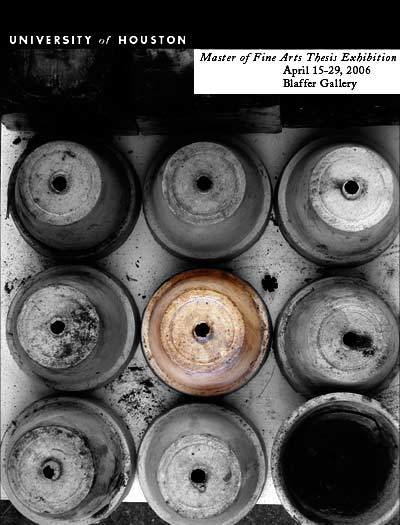I wanted to invite you to join me at the opening reception and brown bag tour for my thesis exhibition at the Blaffer gallery.
Kathy Kelley
Opening Reception
Friday, April 14, 7 to 9
Blaffer Gallery
located at University of Houston
in the Fine Art Building
Brown Bag Gallery Tour with artists,
Kathryn Kelley & Patrick Clifford
Wednesday, April 26, noon
Blaffer Gallery
Exhibition on Display
April 15-29, 10 to 5 (closed Sundays)
Excerpt from Exhibition Catalog
The 2006 School of Art Masters Thesis Exhibition presents works by thirteen students who graduate from the three-year Masters of Fine Arts program this spring with degrees in Ceramics (Patrick Clifford), Graphic Communications (Kathryn Kelley, Ray Ogar, Li Qiao, and Eddy Roberts), Painting (Rabe’a Ballin, Douglas Cason, Kristin Flanagan, Eric Michael Jones, and Janice Weeks), Photography (Rose Cosme and Austin Miller), and Sculpture (Aram Nagle). The exhibition features work from the students’ thesis projects, which culminate their studies and reflect each artist’s development of an individual voice. With this exhibition, which introduces these emerging artists’ works to the larger community, Blaffer reaches its goal to encourage creativity and to nuture independent thought in the university community and beyond.
The artworks in the exhibition, while diverse, share some common approaches and concerns. Three artists employ processes that pair the element of chance with control to explore formal artistic problems. Patrick Clifford uses both random actions and technical facility to make his subtle, minimalist stoneware pieces. Creating her paintings on the floor, Kristin Flanagan carefully pours acrylic paint on panels and then manipulates the surface with an airbrush or other tools to create refined, precise works that explore perception: the subtle shift between the macrocosm and the microcosm, between abstraction and representation. Using the most uncontrollable media of the three artists, Kathryn Kelley makes sculptural reliefs using tar in combination with plaster, nails, wire, or wood. The resulting works often defy the boundaries that attempt to contain them. The shallow, monochromatic spaces give an illusion of depth, implying an unknown quantity, and incorporate found objects to create dense, highly tangible works.
Other artists look outward, tackling social issues and public history—making observations about the past or speculations about the future to comment on the present. Douglas Cason’s library invites viewers to explore a selection of books with reinvented contents: the artist has altered the covers and texts by taking the books apart, drawing upon their pages, and finally rebinding them. Inspired by our increasingly high-tech culture, Ray Ogar comments on our changing communication tools and the potential dangers that accompany them. The artist offers a portal to an imaginary simulated world that is somewhat futuristic, but also conjures Victorian sensibilities. Also interested in the images of technology within society, Eddy Roberts makes video works that feature hand movements or gestures. He uses contour lines to give shape to hands and arms as they move through space in ordinary motions, bringing the personal space of the body to the digital environment. Examining the outcomes of globalization, Li Qiao offers Awakened Dragon, which melds a ubiquitous symbol of China’s prosperity, good fortune, and ascendancy with contemporary Western advertising. Commenting on the interrelation of Eastern and Western cultures and marketplaces, Li’s work embodies the tension between them.
While the artists discussed above are motivated by events and social forces in the public realm, other artists in the exhibition delve deeply into the pools of memory to create highly personal narratives that resonate with viewers’ experiences. Though her subject matter draws directly from her own life, Rabe’a Ballin’s portraits never let the viewer glimpse their subjects’ faces but instead shows the backs of their heads. Thus, the artist portrays her subjects not as specific individuals, but as archetypes. Also informed by his personal history, Aram Nagle has created a built environment where shifts in scale combine with a toy aesthetic to frame an allegory about two brothers as they journey toward adulthood.
The human condition, with all its emotional perils, dilemmas, and complexities, is also a recurrent theme. Austin Miller presents photographs of richly colored street scenes in far-flung locations such as Tokyo, Paris, Mexico City, and London, often glimpsed through the reflections of polished storefront windows. Navigating the territory between the real and the artificial, Rose Cosme’s photographs of domestic interior spaces—dark and dramatically lit—are inhabited by prosthetic devices or dummies, sometimes used in combination to fashion substitutes for human beings.. Also depicting extraordinary figures engaged in ordinary behavior, Eric Michael Jones explores complex interactions between children and adults, investigating both the mental state of children—fueled by compassion or cruelty—and adults’ emotional responses to them: tenderness and protectiveness as well as more sinister reactions. Examining the effects that mental states have on the physical realm, Janice Weeks’s work uncovers the internal and external spaces of the body, focusing on the internal processes of the arteries, the skin, or that most essential and symbolically loaded organ, the heart.

